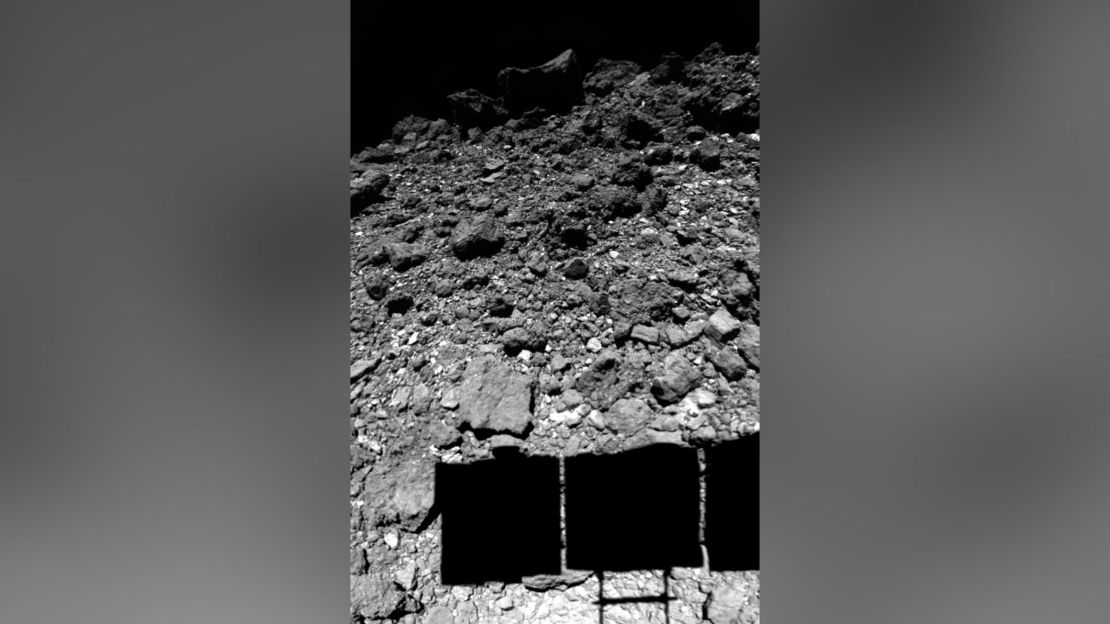When the Japan Aerospace Exploration Agency’s Hayabusa2 spacecraft briefly touched down on near-Earth asteroid Ryugu, scientists noticed two different colors of material on the asteroid’s surface.
One was more red, while the other was more blue. Now, based on new analysis of the observations captured by the spacecraft, scientists know why.
Ryugu, like Icarus in Greek mythology, strayed a little too close to the sun at some point in its history.
Hayabusa2 touched down on Ryugu on February 21, 2019, to collect a sample that is currently en route to Earth and will return in December 2020 after departing the asteroid in December 2019. This touchdown also allowed the spacecraft’s camera to observe the asteroid’s surface in detail.

This landing event also caused the spacecraft’s thrusters to send up a spray of material. It disturbed a coating of dark, fine-grained material on the asteroid similar to reddish materials on the asteroid’s surface. This was compared with the position of the asteroid’s craters.
And that’s when Tomokatsu Morota, study author and associate professor at the University of Tokyo, and his colleagues determined “that the red, dark fine grains lifted up by the thrusters immediately after touchdown were produced by solar heating,” Morota said in an email to CNN.
“We also found that surface alteration by solar heating occurred over a short period of time based on the stratigraphic relationship between identified craters and the redder material. These results suggest that Ryugu underwent an orbital excursion near the sun.”
The study published Thursday in the journal Science.
Asteroids don’t just go rogue and head for the sun. Their movements are governed by the orbits of planets.
“In general, near-Earth asteroids are thought to be transported from the asteroid main-belt to near-Earth orbits by orbital resonance with Jupiter and Saturn,” Morota said. “We think that Ryugu underwent an orbital excursion near the sun when Ryugu was transported from the main belt to an near-Earth orbit.”
This also could have happened once Ryugu became a near-Earth asteroid, said Patrick Michel, study coauthor and director of research at the French National Centre for Scientific Research in Paris.
“When an asteroid becomes a near-Earth one, close encounters with planets perturb their trajectory, and they experience a kind of random walk in their mean distance to the sun,” Michel wrote in an email to CNN. “In the case of Ryugu, planetary perturbations were such that they lead it closer to the sun at some point, and then to its current orbit.”
Michel added that asteroids don’t experience a typical evolution. Their unique trajectories are controlled by planets.
Fortunately, the sample being returned to Earth contains a mix of materials from the asteroid’s surface – including the evidence of the asteroid’s excursion towards the sun.
The sample can contain clues about Ryugu’s history, which are otherwise difficult to understand.
“Unfortunately, there is no way to trace back the evolution of this asteroid by starting the calculations from its present orbit and compute it back in time,” Michel said. “This is not possible for asteroids like Ryugu that have a very chaotic evolution due to its close approaches with planets.”
This will help scientists not only to understand Ryugu better, but other aspects of our solar system’s history as well.
“How such molecules change chemically by solar heating is important for understanding the chemical evolutions of organic molecules, which may have been transported to the early Earth,” Morota said.
Since visiting Ryugu, Hayabusa2 has returned a wealth of data for scientists to study and analyze before the samples ever return to Earth.
Ryugu is a dark, spinning top-shaped asteroid that measures about 3,000 feet wide. The surface is covered in boulders. It’s also incredibly dry.
Photos captured by the spacecraft have revealed an even distribution of dark and rough rocks, as well as those that are bright and smooth. Scientists believe there are two kinds of material on the asteroid because it likely formed from the leftover rubble after its parent body was hit.
The rocks are similar to carbonaceous chondrites, which are primitive meteorites. Some of the rocks contain small, colored materials called inclusions that could contain minerals like olivine. This is also found in carbonaceous chondrites.
Researchers also determined that the asteroid is largely made up of highly porous material. This could explain why carbon-rich meteorites are rarely found on Earth; our atmosphere protects against them and causes them to break apart into fragments.
Information like this, gained by sending a spacecraft to the asteroid, will be compared with data gathered by NASA’s OSIRIS-REx mission visiting another carbonaceous near-Earth asteroid called Bennu.
“All the knowledge we are acquiring with Hayabusa2 could not be obtained from ground-based observations,” Michel said. “So, the detailed characterization of an asteroid definitely needs these space adventures!”










